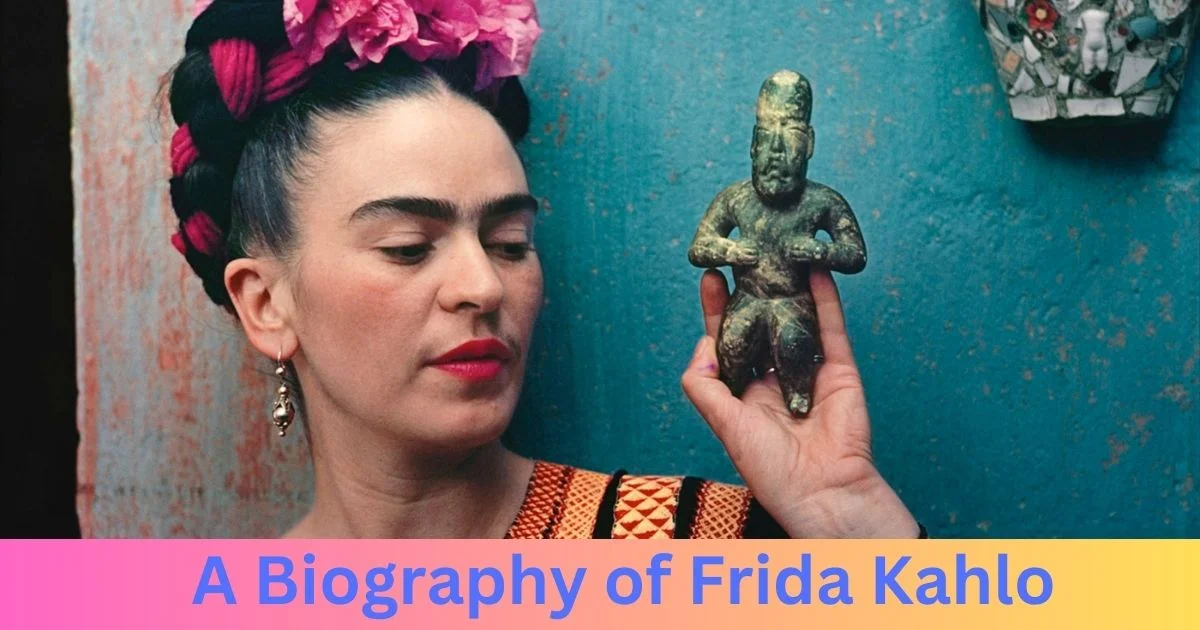Frida Kahlo was an influential Mexican painter known for her striking self-portraits and artwork inspired by indigenous Mexican culture and artifacts. Considered one of Mexico’s greatest artists, she overcame polio as a child and a tragic trolley car accident at age 18 that left her with lifelong health problems. Frida married the famous muralist Diego Rivera and was a central figure in the cultural and artistic renaissance in Mexico in the 1920s-1950s.
Frida Kahlo’s Early Life
Frida Kahlo was born Magdalena Carmen Frida Kahlo y Calderón on July 6, 1907 in Coyoacán, Mexico City, Mexico. Her father, Guillermo Kahlo, was a German photographer who had immigrated to Mexico, and her mother, Matilde Calderón y Gonzalez, was of Spanish and Indigenous Mexican descent.
Frida’s Childhood and Health Struggles
As a child, Frida contracted polio at age 6, which caused her right leg to be much thinner than her left. She wore long skirts to cover up this imperfection. At age 18, she was in a horrific trolley car accident that resulted in multiple injuries including a broken spinal column, collarbone, ribs and pelvis, and a steel handrail pierced her abdomen and uterus. She spent over a month in the hospital and had over 30 operations in her lifetime due to lingering effects of the accident.
| Age | Key Event in Frida’s Early Life |
|---|---|
| 6 years old | Contracts polio, leaving her right leg damaged |
| 18 years old | Severely injured in a trolley accident, causing lifelong health issues |
| 22 years old | Joins Mexican Communist Party |
The trolley car accident had a profound impact on Frida’s life and artwork. She channeled her pain and suffering into create visceral, surrealist self-portraits and paintings. Her work also reflected her Mexican heritage and identity.
Frida’s Art Education and Early Paintings
Even as a child recovering from polio, Frida was very creative and thoughtful. After the bus accident, she began painting while bedridden. Frida studied at the renowned Escuela Nacional Preparatoria school in Mexico City in the mid-1920s. She was one of only 35 female students out of 2,000. Many of her early paintings, sketches and drawings were of herself, her friends, and schoolmates.
Frida’s talent and unique style were evident from the start. She blended surrealism, realism and symbols of Mexican culture in striking ways. Her 1927 self-portrait in a velvet dress displayed her artistic flair and eye for color. Frida’s still life paintings of fruit and flowers also show her burgeoning talent during this period:
| Year | Early Frida Kahlo Paintings |
|---|---|
| 1927 | Self-Portrait in Velvet Dress |
| 1929 | Fruit of the Earth |
| 1931 | Frieda and Diego Rivera |
She developed her own unique, avant-garde style that blended surrealism and Mexican folk styles. During her student years she also became politically active and joined the Mexican Communist Party in 1927.
Frida’s Marriage to Diego Rivera
A key moment in Frida Kahlo’s life was when she met the famous Mexican muralist Diego Rivera in 1928. Despite him being 20 years older, they married the next year in 1929. Their marriage was tumultuous, as both Frida and Diego had numerous extramarital affairs. However, their bond was strong, and they were important influences on each other’s art.
Frida and Diego lived in Mexico as well as the United States during their marriage. They spent significant time in San Francisco, Detroit and New York City. Frida struggled with anxiety about Diego’s frequent infidelities during their years in the US. They eventually divorced in 1939, but remarried in 1940. Their second marriage lasted until Frida’s death in 1954.
Frida’s Artistic Development in the 1930s
In the early 1930s, Frida developed her signature surrealist self-portrait style. Her paintings from this decade, such as Frieda and Diego Rivera (1931) and My Dress Hangs Here (1933), show her technical skill in realism and use of symbolism.
